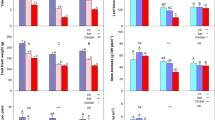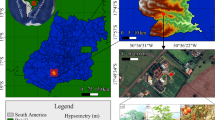Abstract
The salinity tolerances (NaCl) of 8 normal-fruited tomato cultivars (Lycopersicon esculentum Mill.) and 4 cherry tomato cultivars (L. esculentum var.cerasiforme) were determined by yield-substrate EC response curves, according to the Mass-Hoffman model, modified by van Genuchten and Hoffman (1984). The same model was used to determine the response curves of leaf dry-weight, stem dry-weight, and plant height against substrate EC and also between yield and leaf concentrations of Cl- and Na ions.
According to the salinity-threshold (maximum EC-value without yield reduction) and slope (yield decrease per unit EC increase) parameters, determined from the yield-EC response curves, the cherry tomato cultivars were more salt-tolerant than the normal-fruited ones. However, on the basis of vegetative growth characters-EC response curves, cherry tomato cultivars and normal-fruited ones were similarly affected by NaCl.
The ranking of the cultivars by their salinity tolerance, determined from the plots of yield vs. leaf concentrations of Cl- and Na ions, was the same as that evaluated from the yield vs. substrate EC plots.
Similar content being viewed by others
References
Anastasio G, Catala M S, Palomares G, Costa J, and Nuez F 1987 An assessment of the salt tolerance in several tomato genotypes. 10th Meeting of the Tomato Working Group of Eucarpia, Salerno (Italia). pp 57–61.
Bingham F T, Strong J E, Rhoades J D and Keren R 1985 An application of the Maas-Hoffman salinity response model for boron toxicity. Soil Sci. Soc. Am. J. 49, 672–674.
Finlay K W and Wilkerson G N 1963 The analysis of adaptation in a plant breeding programme. Aust. J. Agric. Res. 14, 742–754.
Guerrier G 1984 Selectivité de fixation du sodium au niveau des embryons et des jeunes plantes sensible ou tolerante au NaCl. Can. J. Bot. 62, 1791–1798.
Hobson G E and Bedford L 1989 The composition of cherry tomatoes and its relation to consumer acceptability. J. Hortic. Sci. 64, 321–32.
Johnson C M, Huston R P and Ozanne P C 1958 Measurement of microgram amounts of chlorine in plant materials. Agric. Food. Chem. 6, 114–118.
Jones R A 1986 High salt tolerance potential inLycopersicon species during germination. Eurphytica 35, 575–582.
Maas E V and Hoffman G J 1977 Crop salt tolerance: Current assessment. J. Irrig. Drainage. Div., American Society of Civil Engineers, 103 (IR2), 116–134.
Marquardt D W 1963 An algorithm for least-squares estimation of non-linear parameters. J. Soc. Ind. Appl. Math. 11, 431–441.
Picha D H 1986 Effect of harvest maturity on the final fruit composition of cherry and large-fruited tomato cultivars. J. Am. Soc. Hortic. Sci. 111, 723–727.
Rush D W and Epstein E 1976 Genotypic responses to salinity: Differences between salt-sensitive and salt-tolerant genotypes of the tomato. Plant Physiol. 57, 162–166.
Rush D W and Epstein E 1981 Comparative studies on the sodium, potassium and chloride relations of a wild halophytic and a domestic salt-sensitive tomato species. Plant Physiol. 68, 1308–1313.
Shannon, M C 1985 Principles and strategies in breeding plants for higher salt tolerance. Plant and Soil 89, 227–241.
Shannon M C, Gronwald J W and Tal M 1987 Effects of salinity on growth and accumulation of organic and inorganic ions in cultivated and wild tomato species. J. Am. Soc. Hortic. Sci. 112, 416–423.
van Genuchten M Th 1983 A general optimization method for analyzing crop salt tolerance data: Model description and User's Manual. USDA-ARS, U.S. Salinity Laboratory. Res. Rep. 120. U.S. Government Printing Office, Washington, DC.
van Genuchten M T and Hoffman G J 1984 Analysis of crop salt tolerance data.In Soil Salinity under Irrigation. Ecological Studies. Vol. 8. Eds. I Shainberg and J Shalhevet. pp 258–271. Springer-Verlag, Berlin.
Warnock S J 1988 A review of taxonomy and phylogeny of the genus Lycopersicon. HortScience 23, 669–673.
Yeo A R and Flowers T J 1986 Salinity resistance in rice (Oryza sativa L.) and a pyramiding approach to breeding varieties for saline soils. Aust. J. Plant Physiol. 13, 161–173.
Author information
Authors and Affiliations
Rights and permissions
About this article
Cite this article
Caro, M., Cruz, V., Cuartero, J. et al. Salinity tolerance of normal-fruited and cherry tomato cultivars. Plant Soil 136, 249–255 (1991). https://doi.org/10.1007/BF02150056
Received:
Revised:
Issue Date:
DOI: https://doi.org/10.1007/BF02150056




